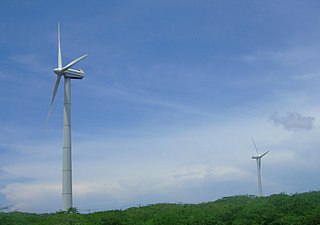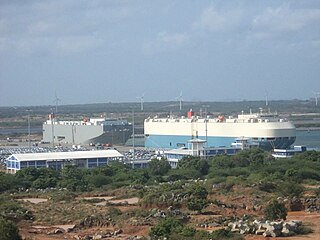
Hambantota is the main town in Hambantota District, Southern Province, Sri Lanka. This underdeveloped area was hit hard by the 2004 Indian Ocean tsunami and is undergoing a number of major development projects including the construction of a new sea port and international airport finished in 2013. These projects and others such as Hambantota Cricket Stadium are said to form part of the government's plan to transform Hambantota into the second major urban hub of Sri Lanka, away from Colombo.
Beliatta is a town located in the Hambantota District of Sri Lanka. It is inland town, approximately, 7 km (4.3 mi) from the coastal town of Tangalle. Beliatta has the second highest mountain range located in the Beliatta Divisional Secretariat area on the boundary of Hambantota & Matara districts. The mountain peaks at about 239 m (784 ft) high. Beliatta town is fed by fountain water originating from Rilagala mountain range.

The Hambantota Wind Farm was a wind farm in Hambantota, Sri Lanka, owned and operated by the state-run Ceylon Electricity Board. The wind farm, which was located along south-eastern coast of Hambantota was the country's first state owned wind farm, and consisted of five NEG Micon M1500-600 wind turbines of 600 KW each. With a total installed capacity of 3 MW, the wind farm generated up to approximately 4,500 MWh of power a year.

Mahinda Rajapaksa International Cricket Stadium, also known as Sooriyawewa International Cricket Stadium, and abbreviately as MRIC Stadium, is an international cricket stadium in Hambantota, Sri Lanka. It was built for the 2011 Cricket World Cup and hosted two matches, the first being Sri Lanka against Canada, on 20 February 2011. The stadium has a capacity of 35,000 people making It the second largest stadium in Sri Lanka.

The Hambantota International Port is a deep water port in Hambantota, Sri Lanka. It was opened on 18 November 2010, and is Sri Lanka's second largest port, after the Port of Colombo. In 2020, the port handled 1.8 million tonnes of LPG and dry bulk cargo.

The electricity sector in Sri Lanka has a national grid which is primarily powered by hydroelectric power and thermal power, with sources such as photovoltaics and wind power in early stages of deployment. Although potential sites are being identified, other power sources such as geothermal, nuclear, solar thermal and wave power are not used in the power generation process for the national grid.

Lakshman Namal Rajapaksa is a Sri Lankan politician. He is the eldest of son of Sri Lankan former President and Prime Minister Mahinda Rajapaksa and a member of parliament. He was the Minister of Youth and Sports from 2020 to 2022.
The Hambantota Solar Power Station is the first commercial-scale solar power station in Sri Lanka. The photovoltaic solar facility was constructed in Buruthakanda, in the Hambantota District. The plant is owned and operated by the Sri Lanka Sustainable Energy Authority, a state-run organization responsible for renewable resources.

China–Sri Lanka relations are the bilateral relations between the People's Republic of China and Democratic Socialist Republic of Sri Lanka. There is a Chinese embassy located in Colombo and a Sri Lankan embassy situated in Beijing. Historical and cultural ties between the two countries extend back hundreds of years.
Deshamanya Neville Ubeysingha Jayawardena (1908–2002) was a Sri Lankan Senator, economist, banker and entrepreneur. He was the first Ceylonese Governor of the Central Bank of Ceylon and founder of the Mercantile Group of Companies that formed the Merc Bank Sri Lanka, Sampath Bank and the former Mercantile Credit Ltd.
DFCC Bank was set up in 1955 as Sri Lanka's a pioneer development finance institution on the recommendation of the World Bank and is one of the oldest development banks in Asia.
The Rajapaksa family is a Sri Lankan family that is prominent in politics. It was one of Sri Lanka's most powerful families during Mahinda Rajapaksa's presidency, when many members of the family occupied senior positions in the Sri Lankan state. As their political power grew, there were reports suggesting that the country was heading towards autocracy under their rule. Following the unexpected defeat of Mahinda Rajapaksa in the 2015 presidential election, they have been accused of authoritarianism, corruption, nepotism and bad governance. In the 2019 presidential election, Gotabaya Rajapaksa, the brother of Mahinda Rajapaksa, ran and won. The popularity of the Rajapaksa family collapsed after their actions caused the economic crisis that started in 2019, resulting in Sri Lanka defaulting on its debt for the first time in its post-independence history within just 30 months of coming to power.

Corruption is considered a major problem in Sri Lanka, and weak whistleblower protections have negative impacts on citizen's willingness to stand up against corruption. Despite some recent institutional reforms by the government in order to fight corruption, whistleblower protections need to be improved. Corruption exists on all levels of society from the top echelons of political power to minor staff level. The problems are long-standing, and despite ongoing calls for reform, and many attempts to improve the situation, there is little evidence of progress. Most of the Sri Lankan also consider bribery is just a fact of life especially bribing a public official to get the job done.
The Ace Horana Power Station was a 25-megawatt thermal power station in Horana, Sri Lanka. The plant operated from 2002-2012 similar to that of the Ace Matara Power Station, and utilized four 6.3 MWWärtsilä 18V32LN generating units. The plant was decommissioned in 2012 after its 10-year PPA expired. The power station was originally planned to be built in Anuradhapura, but was later changed to Horana due to environmental and religious protests.
Union Bank of Colombo PLC, commonly referred to as UBC, is a commercial bank in Sri Lanka. It is licensed by the Central Bank of Sri Lanka, the central bank and national banking regulator.
The Laugfs Solar Power Station is a 20-megawatt photovoltaic power station built 10 km (6.2 mi) north of Hambantota, in the Hambantota District of Sri Lanka. It is the single largest solar power station in the country. Construction of the Rs. 5 billion power station was ceremonially inaugurated on 18 February 2016, and completed in October 2016.
The Solar One Ceylon Power Station is a 12.56-megawatt solar photovoltaic farm built in January 2017 at Welikanda, in the Polonnaruwa District of Sri Lanka. The solar farm utilizes 315W and 320W polycrystalline modules manufactured by JA Solar Holdings, which are installed over 624 single-axis solar trackers supplied by the Spanish firm Grupo Clavijo. The trackers are expected to boost production up by 20%, compared to a fixed tilt setup.
Debt-trap diplomacy is an international financial relationship where a creditor country or institution extends debt to a borrowing nation partially, or solely, to increase the lender's political leverage. The creditor country is said to extend excessive credit to a debtor country with the intention of extracting economic or political concessions when the debtor country becomes unable to meet its repayment obligations. The conditions of the loans are often not publicized. The borrowed money commonly pays for contractors and materials sourced from the creditor country.

The Sri Lankan economic crisis is an ongoing crisis in the island-state of Sri Lanka that started in 2019. It is the country's worst economic crisis since its independence in 1948. It has led to unprecedented levels of inflation, near-depletion of foreign exchange reserves, shortages of medical supplies, and an increase in prices of basic commodities. The crisis is said to have begun due to multiple compounding factors like tax cuts, money creation, a nationwide policy to shift to organic or biological farming, the 2019 Sri Lanka Easter bombings, and the impact of the COVID-19 pandemic in Sri Lanka. The subsequent economic hardships resulted in the 2022 Sri Lankan protests.









